
IRIS login | Reed College home Volume 92, No. 1: March 2013
You Did It!
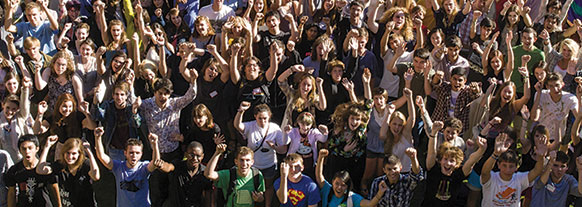
By Randall S. Barton and Matt Kelly
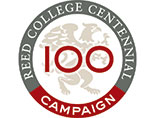
The obstacles would have daunted Odysseus. But Reed alumni, parents, and friends—yes, loyal readers, that’s you—have successfully completed the most ambitious campaign in our 100-year history.
The Centennial Campaign was launched in 2005 with the goal of preparing Reed to face the challenges of the next century. Within two years, the U.S. economy slid into the worst downturn since the Great Depression. Against great odds, including increasing pressure on higher education, readers of this magazine came through with gifts totalling more than $200 million.
Ultimately this campaign was about people, not money, and we’d like to share how you invested in them. These are the achievements of the Centennial Campaign.
“In an age where so much has changed, Reed’s founding precepts remain relevant, powerful, and—thankfully—largely unchanged. The education program is long and expensive, but it has produced remarkably effective people, from scholars to business leaders, who’ve made important contributions to society . . . I still believe in the importance of a well-developed life of the mind as something of real and lasting value. I am gratified that Reedies today still care as much about these ideals as they did 50 years ago when I was a student.”
—Daniel Greenberg ’62 Launched the Centennial Campaign with a pledge of $10 million.
![]()
Integrity
From its founding, Reed has been guided by the principle of integrity—integrity in its multiple connotations of honor, wholeness, and independence. For individuals on campus, integrity finds voice in an honor principle that governs academic and social behavior. For the institution, it resonates in Reed’s enduring adherence to its founding values and in the determination to measure any single achievement by its contribution to the health of the college as a whole. This campaign called upon every part of the Reed family to come together in a common effort to sustain and nurture our founders’ unique creation.
Alumni, parents, trustees, and friends gave at all levels to surpass this historic goal; in fact, the number of parent and alumni major donors doubled since the last campaign.
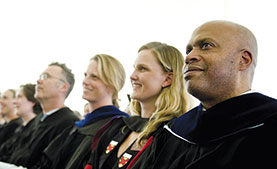
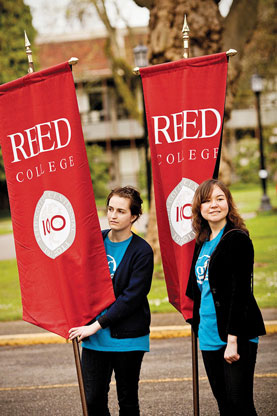
$203,456,896
Total raised by the campaign
$149.7 million
Total added to the endowment during the seven years of the campaign.
12,732
Total number of donors.
62%
Proportion of alumni who gave to the campaign.
889
The number of young alumni donors (defined as alumni who graduated within the past decade) who gave to Reed last year, up 85% from 2004.
612
Reed students who contributed to the campaign through the Reedies for Reedies initiative. There were 286 student donors in 2012 compared to 13 in 2006.
$27,440,226
Given to the Annual Fund. These gifts enable the college to be nimble in responding to its most immediate needs. Dependable annual gifts enable us to welcome freshmen to campus who couldn’t otherwise afford to attend, provide mentorship opportunities with faculty, and help Reed stay on the cutting edge.
“I have a reverence and a deep appreciation for the excellence of Reed College, which is one of the most distinguished and distinctive institutions in the entire Pacific Northwest, and that includes not just educational institutions. There is real quality, authenticity, and integrity to Reed.”
—Colin Diver [president 2002–12]
![]()
Inquiry
A Reed education requires a highly individualized approach. From the intimate setting of a Hum 110 conference, Reed students progress through a variety of experiences that culminate in the scholarly partnership of the senior thesis. To enable the faculty to give every student such personalized attention, the campaign sought to add enough faculty positions to achieve the college’s long-standing goal of a 10-to-1 student-faculty ratio. The faculty also wanted to strengthen small departments and those facing chronically high enrollments, as well as to broaden the reach of the curriculum in a few carefully selected areas.
One area of the curriculum receiving special attention was the performing arts. Investment in the departments of dance, music, and theatre strengthened the contributions that these disciplines make to the overall academic program, and will afford all students valuable opportunities for collaborative work, creative exploration, and expressive performance.
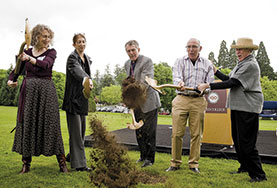

18
New professors were added in anthropology, chemistry, computational biology, economics, environmental studies-chemistry, environmental studies-political science, linguistics, philosophy, political science, psychology, Chinese, English, Russian, Spanish, music, dance, and theatre.
10.16 to one
Student-faculty ratio, meeting a long-held goal.
$13.1 million
Given to construct a performing arts building. Just as scientists need good laboratory space to conduct research, dance, music, and theatre depend on appropriate facilities to learn and perform. This new teaching facility will bring the three performing arts departments into one building packed with stages, studios, classrooms, and practice spaces, at a total cost of $28 million. (The remaining $14 million was financed through bonds.)
$10,600,000
Amount raised for student and faculty research.
Academic Support
Where intellectual life is paramount, knowing how to learn is a primary asset. Reed has developed multiple resources that complement the curriculum and help students manage academic demands through peer tutoring, cooperative study environments, writing support, workshops, and individualized coaching. One such resource is the Dorothy Johansen (DoJo) House.
2,174
Number of times students signed into the Dorothy Johansen House last year.
1,965
Hours of individual tutoring provided last year, up nearly 30% from the previous year.
"The liberal arts allow you to make multiple suppositions and to explore possibilities in an intellectual way. If you’re doing a production of A Doll’s House, you have to make a whole bunch of choices and will discover the consequences of those choices. Our lives are filled with situations in which we have to make choices and live with the consequences of those choices. The practice of art teaches something about that."
—Kathleen Worley [theatre 1985—]
"Whether it’s being pushed to defend my ideas in conference, performing EEG research in the lab, or dancing with friends in the SU like no one’s watching, I am grateful for all the academic and social experiences Reed has afforded me. Reed has challenged me and humbled me . . . I am truly grateful to have received financial aid. Thank you for your generosity."
—Loretta Yiu ’13
![]()
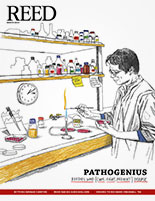

LATEST COMMENTS
steve-jobs-1976 I knew Steve Jobs when he was on the second floor of Quincy. (Fall...
Utnapishtim - 2 weeks ago
Prof. Mason Drukman [political science 1964–70] This is gold, pure gold. God bless, Prof. Drukman.
puredog - 1 month ago
virginia-davis-1965 Such a good friend & compatriot in the day of Satyricon...
czarchasm - 4 months ago
John Peara Baba 1990 John died of a broken heart from losing his mom and then his...
kodachrome - 7 months ago
Carol Sawyer 1962 Who wrote this obit? I'm writing something about Carol Sawyer...
MsLaurie Pepper - 8 months ago
William W. Wissman MAT 1969 ...and THREE sisters. Sabra, the oldest, Mary, the middle, and...
riclf - 10 months ago